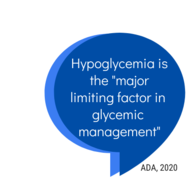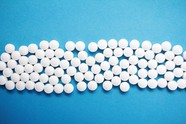|
This is a new publication from the Montana DPHHS. You are receiving this informative newsletter, written by a pharmacist for a pharmacy-based audience, in effort to help drive and improve care for people with diabetes in Montana. Please share with your colleagues and encourage them to subscribe as well.
If you are interested in becoming accredited or recognized for diabetes education please contact us for financial and mentoring support!
Hypoglycemia: Community Pharmacists Can Help
It is estimated that people with Type 2 diabetes treated with insulin and/or oral agents, including sulfonylureas, average 19 episodes of mild to moderate and 1 episode of severe hypoglycemia yearly.
"Hypoglycemia is recognized as an important public health issue, leading to increased mortality and hospital readmission rates. For people with diabetes, the threat and fear of hypoglycemia, whether spontaneous or therapy-associated, is one of the most significant barriers to glycemic management.” -The Association of Diabetes Care and Education Specialists
The American Diabetes Association defines and classifies hypoglycemia as:
|
Level 1: < 70 mg/dL but > 54 mg/dL. Level 1 is considered clinically important because many patients have less than adequate counterregulatory response with no symptoms. People without diabetes begin to have a neuroendocrine response as blood sugar drops below 70 mg/dL.
Level 2: <54 mg/dL. Most people will have neuroglycopenic (shortage of glucose in the brain) and adrenergic symptoms at this level. Those who do not may have hypoglycemic unawareness.
Level 3: A severe event characterized by altered mental and/or physical status requiring assistance for treatment of hypoglycemia.
|
|
 |
Causes

- Imbalance of medication, physical activity, and nutrient intake
- Use of medications that can cause hypoglycemia such as insulin and insulin secretagogues including the sulfonylureas and meglitinides.
- Alcohol is a known cause of hypoglycemia and can occur hours after consumption.
- ACE-I, ARBs, and nonselective beta blockers can cause hypoglycemia although it is rarely mentioned in the literature and hardly ever results in discontinuation of therapy.
-
NOTE that hydroxychloroquine, according to the prescribing information, can cause severe hypoglycemia. Diabetes patients using this off label for COVID-19 should be alerted.
|
Consequences

The fear of hypoglycemia contributes to the anxiety that many people with diabetes already experience. It may interfere with proper medication taking and result in treatment failure. It may prevent people from exercising or enjoying the recreational opportunities such as hiking that we have here in Montana. Some other significant issues are:
- Severe hypoglycemia is a marker for cardiovascular risk and mortality.
- A history of Level 3 episodes in older adults is associated with dementia.
- Hypoglycemia can result in life altering events such as falls and automobile accidents.
- Fear of or frequent episodes of hypoglycemia can cause glucose variability and weight gain due to overcompensation with food.
|
Prevention
The best thing we can do, as pharmacists, is to identify those patients at risk and educate them. That is easy to do when you look at their medications and see offending agents. Since the majority of folks never see a diabetes educator, we can help by giving them hypoglycemia patient education handouts such as those available from the American Diabetes Association website and suggesting glucose tablets or gel and even glucagon if indicated. If they are not using SMBG then we need to talk about that too.
- Patients need to be made aware of the common symptoms of hypoglycemia, including irritability, shakiness, palpitations, mental confusion, and hunger. At risk patients should know the causes of hypoglycemia, such as skipping or delaying meals, improper medication taking, or doing an unusual amount of exercise without pre-exercise blood sugar monitoring and food intake.
- Avoiding or optimizing the use of medications that are known offenders such as insulin and secretagogues when possible.
- If a sulfonylurea must be used because of cost issues, glimepiride and glipizide are preferred because of their shorter activity. Long acting secretagogues, like glyburide, are not recommended in the elderly.
- Teaching people to be proactive by using effective monitoring before and after exercise and before driving or doing risky things where mental alertness and coordination are important.
- Advise people who have had multiple level 2 or one Level 3 episodes that they need to revise their medication therapy. People with hypoglycemic unawareness and episodes of asymptomatic Level 2 or Level 3 may need to raise their target to a point where no hypoglycemia occurs for several weeks as that can often reverse the unawareness.
Treatment

Episodes of hypoglycemia should be treated preferably with pure glucose although any carbohydrate that contains glucose will suffice.
The rapid glycemic response correlates more with glucose content that carbohydrate content of foods. Added fat can retard absorption of the glucose and added protein can enhance the insulin response while failing to increase glucose concentrations. The glucose tablets or gel from the pharmacy should be recommended for all people at risk as they are easy to carry around and can be kept in convenient places so they are always handy. Usually 3-4 tablets will give 15 grams of pure glucose. Contrary to the use of “whatever I find in the refrigerator” treatment, these glucose preparations give predictable results and involve no guesswork by the patient.
The 15-15 rule for treatment is important to teach and to revisit periodically. When BG is under 70 mg/dL take 15 grams of glucose, wait for 15 minutes and recheck. If results are not satisfactory repeat the treatment until blood sugar is back to normal. Since blood sugar may drop again after normalizing, it is recommended that the person eat a snack or a meal soon thereafter. It is important to note that secretagogues such as sulfonylureas are known to cause sustained hypoglycemia so periodic SMBG should be performed after an event.
Glucagon should be prescribed for all people with Type 1 and Type 2 diabetes who are at risk for level 2 hypoglycemia. Glucagon is now available in a more convenient premixed injectable solution as well as a nasal powder. The nasal powder has the advantage of being easy for a third party to administer even if the patient is unconscious since it requires no action on the patient’s part. Pharmacists should be prepared to educate the patient and caregiver on when and how to use glucagon.
|
Traditional SMBG and CGM
Self-monitoring blood glucose is a foundation of diabetes care. The A1c test is important but does not tell us much about hypoglycemia.
- Meaningful monitoring is that which utilizes blood glucose values as a tool to assess control, interpret the effects of exercise, food, stress, illness, and medications. Monitoring before exercise to prevent hypoglycemia is really important for people at risk by virtue of insulin or secretagogue therapy. If blood sugar is below 90 mg/dL it might be advisable to consume some carbohydrate before beginning the exercise and also carrying a carbohydrate snack or glucose tablets or gel in case symptoms appear.
- The use of continuous glucose monitoring systems (CGM) is becoming an option for most people with Type 1 and some with Type 2 diabetes. The devices we are seeing now, such as the Freestyle Libre and Dexcom G6 are very accurate and dependable. As it relates to hypoglycemia CGM systems are checking blood sugar every few minutes and able to identify downward trends allowing the user to take action before it is to late.
Key Messages
|
Community pharmacists and staff are in a great position to be proactive in helping patients with diabetes who are at risk for hypoglycemia.
- Identify your at-risk patients by looking at their medication profile.
- Question patients about their experiences with hypoglycemia as they come in for refills and do some brief education when they start a new medication such as insulin or a sulfonylurea.
- Consider downloading the hypoglycemia patient handouts from the American Diabetes Association website or some other vetted source and giving the handout to all your patients on insulin and/or secretagogues.
|
|
 |
References
- Prevalence and Incidence of Hypoglycemia in People with Type 2 Diabetes on Oral Therapies and Insulin: Review and meta-Analysis of Population Based Studies, Eldridge et al published online 2015 NCBI.NLM.NIH.gov
- American Diabetes Association Standards of Medical Care in Diabetes 2020
- Association of Diabetes Care and Education Specialists (ADCES) Diabetes Education Impact on Hypoglycemia Outcomes accessed online June 2020 and Recognizing Hypoglycemia as a Public Health Issue
Stay tuned for July's edition: Continuous Glucose Monitoring
|